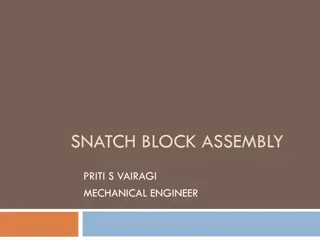Introduction to Mechanical Engineering: Exploring Career Opportunities and Roles
This content delves into the world of mechanical engineering, covering topics such as the characteristics of students interested in engineering, the distinction between engineers and scientists, and the functions of engineers in research. It also provides insights into the differences between engineers and engineering technologists, along with ways to explore engineering career paths. Through illustrations and explanations, the content offers a comprehensive overview of mechanical engineering disciplines and the roles they play in our society.
- Mechanical Engineering
- Career Opportunities
- Engineers vs Scientists
- Engineering Functions
- Engineering Technologists
Download Presentation

Please find below an Image/Link to download the presentation.
The content on the website is provided AS IS for your information and personal use only. It may not be sold, licensed, or shared on other websites without obtaining consent from the author. Download presentation by click this link. If you encounter any issues during the download, it is possible that the publisher has removed the file from their server.
E N D
Presentation Transcript
CHAPTER 2 -Engineering Majors ME101 Dr. Nhut Tan Ho 1
Lecture Objectives & Activities Provide information about different fields of engineering Introduce you to role and job functions of mechanical engineers Introduce you to disciplines within mechanical engineering Active Learning Activities Cooperative learning: ME disciplines 2
2.1 Introduction Several characteristics of students that might have an interest in engineering are: Proficient skills in math and physical science An urging from a high school counselor Knows someone who is an engineer Knows that engineering offers literally dozens, if not hundreds of job opportunities Is aware that a degree in engineering is quite lucrative 3
2.1 Engineers and Scientists Scientists seek technical answers to understand natural phenomenon Engineers study technical problems with a practical application always in mind For example Scientists study atomic structure to understand the nature of matter; engineers study atomic structure to make smaller and faster microchips 4
2.1 The Engineer and the Engineering Technologist Main difference between the two is: Engineers design and manufacture machines and systems, while engineering technologists have the technical know- how to use and install the machines properly An example: The technologist identifies the equipment necessary to assemble a new CD player; the engineer designs said CD player 5
2.1 What Do Engineers Do? Ways to get information about careers: Visit job fairs Attend seminars on campus by various employers Contact faculty with knowledge of engineering fields Get an intern or co-op position Enroll in an engineering elective course 6
2.2 Engineering Functions: Research Research engineers are knowledgeable in principles of chemistry, biology, physics, and mathematics Computer know-how is also recommended A Masters Degree is almost always required, and a Ph. D is often strongly recommended 7
2.2 Engineering Functions: Development Development engineers bridge the gap between the laboratory and the production facility They also identify problems in a potential product An example is the development of concept cars for companies like Ford and GM 8
2.2 Engineering Functions: Testing Testing engineers are responsible for testing the durability and reliability of a product, making sure that it performs how it is supposed to, every time. T.E.s simulate instances and environments in which a product would be used Crash testing of a vehicle to observe effects of an air bag and crumple zone are examples of a testing engineer s duties 9
2.2 Engineering Functions: Design Design aspect is where largest number of engineers are employed Design engineers often work on components of a product, providing all the necessary specifics needed to successfully manufacture the product Design engineers regularly use computer design software as well as computer aided drafting software in their jobs 10
2.2 Engineering Functions: Design Design engineers must also verify that the part meets reliability and safety standards required for the product A concern always on the mind of design engineers is how to keep the development of a part cost effective, which is taken into account during a design process 11
2.2 Engineering Functions: Analysis Analysis engineers use computational tools and mathematic models to enrich the work of design and research engineers Analysis engineers typically have a mastery of: heat transfer, fluid flow, vibrations, dynamics, acoustics, and many other system characteristics 12
2.2 Engineering Functions: Systems Responsible on a larger scale for bringing together components of parts from design engineers to make a complete product Responsible for making sure all components of a product work together as was intended by design engineers 13
2.2 Engineering Functions: Manufacturing & Construction Work individually or in teams Responsible for molding raw materials into finished product Maintain and keep records on equipment in plant Help with design process to keep costs low 14
2.2 Engineering Functions: Operations & Maintenance Responsible for maintaining production line Must have technical know-how to deal w/ problems Responsible for inspecting facility and equipment, must be certified in various inspection methods 15
2.2 Engineering Functions: Technical Support Works between consumers and producers Not necessarily have in depth knowledge of technical aspects of product Must have good interpersonal skills 16
2.2 Engineering Functions: Customer Support Often have more of a technical knowledge than Tech. Support, because they must be able to work with basic customers Evaluate whether or not a current practice is cost effective via feedback from customers 17
2.2 Engineering Functions: Sales Sales engineers have technical background, but are also able to communicate effectively w/ customers Job market for sales engineers is growing, due to the fact that products are becoming more and more technically complex 18
2.2 Engineering Functions: Consulting Are either self-employed, or work for a firm that does not directly manufacture products Consulting engineers might be involved in design, installation, and upkeep of a product Sometimes required to be a registered professional engineer in the state where he/she works 19
2.3 Engineering Majors Mechanical Engineering Concerned with machines and mechanical devices Work in design, development, production, control, and operation of machines/devices Requires a strong math and physics background. Often 4 or more math classes required for graduation 20
Cooperative Learning: Experts Teaching ME Disciplines (1) Student experts teaching 4 ME disciplines 1. Mechanics 1. Stress Analysis (http://en.wikipedia.org/wiki/Strength_of_materials, http://en.wikipedia.org/wiki/Solid_mechanics) Kinematics and Dynamics Thermo-Fluid 1. Thermodynamics (http://en.wikipedia.org/wiki/Thermodynamics) 2. Heat transfer (http://en.wikipedia.org/wiki/Heat_transfer) 3. Fluid Mechanics (http://en.wikipedia.org/wiki/Fluid_mechanics) Design and Manufacturing 1. Design (http://en.wikipedia.org/wiki/Design) 2. Manufacturing (http://en.wikipedia.org/wiki/Manufacturing) Control and Mechatronics 1. Mechatronics (http://en.wikipedia.org/wiki/Mechatronics) 2. 2. 3. 4. 21
Cooperative Learning: Experts Teaching ME Disciplines (2) Cooperative Learning Procedure (60 minutes) 1. Form a base group of 4, each student is assigned a number 1 to 4 2. Each student studies individually or in their group a discipline corresponding to their assigned number (15 minutes) 3. Students with same number form an expert group, discussing the key points of the concept and how to teach the concept to their base group (15 minutes) 4. Students return to their base group and teach the concept to the members (20 minutes) 5. Instructor checks for students understanding (10 minutes) 22
Lecture Recap Engineers have a wide range of roles and job functions Mechanical Engineers are known for expertise and for working in a wide range of systems/machines 23
Next Lecture and Homework Next lecture: Profile of and Investment for the Mechanical Engineering Profession Homework reminder: Q & A 24
2.3 Engineering Majors: Aerospace Engineering Previously known as aeronautical and astronautical engineering First space flight Oct. 4, 1957 (Sputnik I) KEY WORDS: Aerodynamics: The study of the flow of air over a streamlined surface or body. Propulsion engineers: develop quieter, more efficient, and cleaner burning engines. 25
2.3 Engineering Majors: Aerospace Engineering KEY WORDS: Structural engineers: use of new alloys, composites, and other new materials to meet design requirements of new spacecraft Control systems: systems used to operate crafts Orbital mechanics: calculation of where to place satellites using GPS 26
2.3 Engineering Majors: Agricultural Engineering Concerned with finding ways to produce food more efficiently KEY WORDS Harvesting Equip. - removes crops from field, and begins processing of food Structures: used to hold crops, feed, and livestock; Agricultural engineers develop and design the structures that hold crops 27
2.3 Engineering Majors: Agricultural Engineering Food process engineers: concerned with making healthier processed food products Soil/Water Resources: working to develop efficient ways to use limited resources 28
2.3 Engineering Majors: Architectural Engineering Structural: primarily concerned with the integrity of the building structure. Evaluates loads placed on buildings, and makes sure the building is structurally sound Mechanical systems: control climate of building, as well as humidity and air quality (HVAC) 29
2.3 Engineering Majors: Biomedical First recognized in 1940 s Three basic categories: Bioengineering, Medical, and Clinical Bioengineering is application of engineering principles to biological systems Medical engineers develop instrumentation for medical uses Clinical engineers develop systems that help serve the needs of hospitals and clinics 30
2.3 Engineering Majors: Chemical Emphasizes the use of chemistry and chemical processes in engineering Chemical engineers develop processes to extract and refine crude oil and gas resources Chemical engineers also develop circuit boards, and work in the pharmaceutical industry, where processes are designed to create new, affordable drugs 31
2.3 Engineering Majors Civil Engineering First seen in pyramids of Egypt Structural engineers most common type of civil engineer Transportation engineers concerned w/ design and construction of highways, railroads, and mass transit systems Surveyors start construction process by locating property lines and property areas 32
2.3 Engineering Majors Computer Engineering Focuses primarily on computer hardware, not software Work w/ electrical engineers to develop faster ways to transfer information, and to run the computer Responsible for the architecture of the computer system 33
2.3 Engineering Majors Electrical Engineering More engineers are electrical than any other discipline With an ever growing technological society, electrical engineers will ALWAYS have a job Work in communications, microelectronics, signal processing, bioengineering, etc 34
2.3 Engineering Majors Environmental Engineering Often coupled with Civil Engineering 3 aspects of environmental engineering: Disposal: disposing of industrial/residential waste products Remediation: clean up of a contaminated site Prevention: working with corporations to reduce and/or prevent emissions and work to find ways to recycle products to be used again to reduce waste 35
2.3 Engineering Majors Industrial Engineering Design, improvement, and installation of integrated systems of people, material, and energy Emphasis placed on: Production, Manufacturing, Human Factors Area, and Operations Research Production focuses on plant layout, scheduling, and quality control Human Factors focuses on the efficient placement of human resources within a plant/facility 36
2.3 Engineering Majors Marine and Ocean Engineering Concerned with the design, development, and operation of ships and boats Marine engineer designs and maintains the systems that operate ships, I.e. propulsion, communication, steering and navigation Ocean engineer design and operates marine equipment other than ships, such as submersibles. O.E.s might also work on submarine pipelines and/or cables and drilling platforms 37
2.3 Engineering Majors Materials Engineering Study the structure, as well as other important properties of materials, I.e. strength, hardness, and durability Run tests to ensure the quality of the performance of the material Material Engineers also study metallurgy, and the development of composites and alloys 38
2.3 Engineering Majors Mining Engineering Work to maintain constant levels of raw minerals used every day in industrial and commercial settings Must discover, remove, process, and refine such minerals 39
2.3 Engineering Minerals Nuclear Engineering Most concerned with producing and harnessing energy from nuclear sources Propulsion and electricity are the main uses of nuclear power Engineers also responsible for disposal of the nuclear waste byproduct, and how to keep people safe from harmful nuclear products 40
2.3 Engineering Majors Petroleum Engineering Discover, remove, refine, and transport crude and refined oil around the world PE s design and operate the machinery used to refine crude oil into its many forms 41























